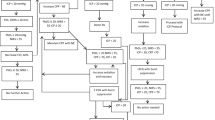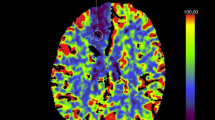Summary
We evaluated bedside cerebral on-line microdialysis for early detection of cerebral hypoxia in patients with traumatic brain injury. 24 severely head injured patients (Glasgow Coma Score ≤ 8) were studied. Patients underwent continuous brain tissue PO2 (PtiO2) monitoring using the LICOX (GMS mbH, Germany) microcatheter device. The catheter was placed into the non-lesioned frontal white matter within 32.2 (7–48) hrs post injury. The microdialysis catheter (CMA 100, Sweden) was placed close to the PtiO2 probe via a 2- or 3-way skull screw, connected to a pump and perfused with Ringer solution (0.3 μl/min). The microdialysis samples were collected hourly and analyzed at the bedside for glucose, lactate, lactate-pyr-uvate-ratio and glutamate (CMA 600, Sweden). We identified 252 episodes of impending hypoxia (PtiO2 < 15 mmHg; 11810 minutes) and 38 episodes of cerebral hypoxia (PtiO2 < 10 mm Hg; 1996 minutes). Before cerebral hypoxia, glucose decreased significantly. Glutamate was unchanged when no hypoxia or impending hypoxia occurred but increased 3–4fold before a hypoxic episode appeared. We conclude that early metabolic detection of cerebral hypoxia before a critical decrease in brain tissue PtiO2 is seen and possibly allows earlier changes in treatment (e.g. reduction of hyperventilation therapy).
Supported by Deutsche Forschungsgemeinschaft Un-56/7.
Access this chapter
Tax calculation will be finalised at checkout
Purchases are for personal use only
Similar content being viewed by others
References
Dings J, Meixensberger J, Roosen K (1997) Brain tissue PO2-monitoring: catheter stability and complications. Neurol Res 19: 241–245
Hillered L, Persson L, Ponten U, Ungerstedt U (1990) Neuro-metabolic monitoring of the ischaemic human brain using microdialysis. Acta Neurochir (Wien) 102: 91–97
Kiening KL, Unterberg AW, Bardt TF, Schneider G-H, Lanksch RW (1996) Monitoring of cerebral oxygenation in severely head-injured patients: brain tissue PO2 vs jugular venous oxygen saturation. J Neurosurg 85: 751–757
Miller JD, Becker DP (1982) Secondary insults to the injured brain. J R Coll Surg Edinburgh 27: 292–298
Robertson CS, Gopinath SP, Uzura M, Valadka AB, Goodman JC (1998) Metabolic changes in the brain during transient ischemia measured with microdialysis. Neurol Res 20 [Suppl] 1: 591–594
Ungerstedt U, Hallstrom A (1987) In vivo microdialysis - a new approach to the analysis of neurotransmitters in the brain. Life Sci 41: 861–864
Valadka AB, Gopinath SP, Contant CF, Uzura M, Robertson CS (1998) Relaionship of brain tissue PO2 to outcome after severe head injury. Crit Care Med 26: 1576–1581
Van den Brink WA, Van Santbrink H, Steyerberg EW, Avezaat CJJ, Carmona Suazo JA, Hogesteeger C, Jansen WJ, Kloos LMH, Vermeulen J, Maas IR (2000) Brain oxygen tension in severe head injury. Neurosurgery 46: 868–876
Zauner A, Bullock R, Kuta AJ, Woodward J, Young HF (1996) Glutamate release and cerebral blood flow after severe human head injury. Acta Neurochir (Wien) [Suppl] 67: 40–44
Author information
Authors and Affiliations
Editor information
Editors and Affiliations
Rights and permissions
Copyright information
© 2002 Springer-Verlag
About this paper
Cite this paper
Sarrafzadeh, A.S., Sakowitz, O.W., Callsen, TA., Lanksch, W.R., Unterberg, A.W. (2002). Detection of Secondary Insults by Brain Tissue pO2 and Bedside Microdialysis in Severe Head Injury. In: Czosnyka, M., Pickard, J.D., Kirkpatrick, P.J., Smielewski, P., Hutchinson, P. (eds) Intracranial Pressure and Brain Biochemical Monitoring. Acta Neurochirurgica Supplements, vol 81. Springer, Vienna. https://doi.org/10.1007/978-3-7091-6738-0_81
Download citation
DOI: https://doi.org/10.1007/978-3-7091-6738-0_81
Publisher Name: Springer, Vienna
Print ISBN: 978-3-7091-7397-8
Online ISBN: 978-3-7091-6738-0
eBook Packages: Springer Book Archive




